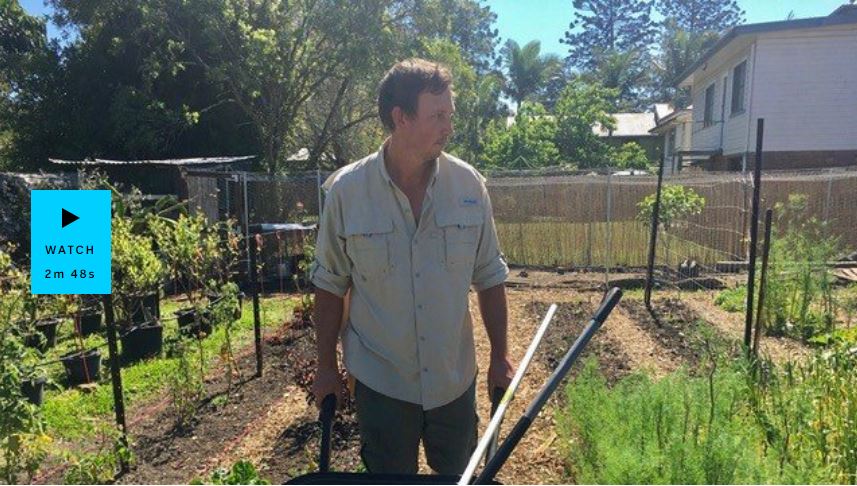
In the backyard of his 500-square-metre rental property, biologist James Stanistreet has created a garden capable of feeding his family of four — and many more.
Key points:
A student biologist says his average-sized backyard is large enough to feed a family
He says all elements of a garden have an important role to play, even weeds
A garden is most productive when you care for all aspects of the ecosystem
Chicken and ducks fertilise and carry out pest control on neat rows of vegetables and fruit trees while native bees set to work on pollination.
Mr Stanistreet said his northern New South Wales garden produces more than enough for his family, the rest he trades with neighbours or sells at the local farmers’ market.
He is completing a Bachelor of Science at Southern Cross University in Lismore, focussing on the symbiotic association between fungi and tomato plants, and how advancing that knowledge can help minimise the use of industrial nitrogen.
When not in the laboratory he works his day job — designing, building, and planting ‘agroforests’ for private landholders that can incorporate everything from cabinet timbers to commercial-scale food production or native revegetation.
He has devoted years to understanding plants and using this knowledge to create his thriving back yard food bowl.
“A lot of what this garden is about is testing out ideas and seeing what can happen when we change what we do and put different things into practice.”
Weeds not the enemy
Mr Stanistreet said he uses cover crops, such as clover and other ‘weeds’, to fix nitrogen to the soil rather than relying on manufactured chemicals.
“You don’t see weeding in nature, yet trees grow very strong and healthy and it is because there is that organic matter and each plant has a role to play,” he said.
“What humans see as a weed it’s not just something trivial, it is something that the environment requires. It has a place and a role and it’s been developed over millions of years.
“Unfortunately we just weren’t able to see that in the past. Now we are really focussing on them and saying ‘okay, what is their role? What do they do?'”
Mr Stanistreet lets many of his crops go to seed, producing flowers that attract bees and hover flies to pollinate the garden, and wasps to eat pests including aphids.
“You have to remember you are looking after a whole ecosystem here,” he said.
It also allows him to collect the seed for the next crop, which he does by hanging the plant upside down over a large bowl and shaking it once the plant is dry.
He rotates his crops to deprive a ready food source for parasitic nematodes — bugs that live in the soil and can destroy a plant’s root system.
He keeps his garden beds at 70 centimetres wide because a lot of tools are made at that width, with a 30cm walkway between beds.
Each bed is topped up annually with woodchips that will decompose and add nutrients to the soil.
Between crops in any one bed he will add 100 litres of manure, 200 litres of compost, along with regular additions of fish and seaweed emulsions.
To keep costs down he makes his own compost, collects seaweed from the beach, and has a worm farm to produce castings and tea for the garden.
Find more local news
Tell us your location and find more local ABC News and information
Fantastic fowl
Ducks and chickens share Mr Stanistreet’s backyard coop, but the birds play very different roles in the garden.
When a crop is finished and a bed needs to cleared and fertilised, he fences it off and puts the chickens to work scratching it up.
The ducks are often left to roam the garden, picking off the slugs in the morning and other insects that would otherwise attack the produce.
The chickens are given kitchen scraps and garden trash, while their bedding and manure gets composted and returned to the garden beds.
“It is a closed system in many ways and these animals certainly help with that,” he said.
Mr Stanistreet said although his biology degree is helping him with the theory, anyone can use whatever space they have in their yards to grow food.
“Just get a seed of anything and find some soil and just start,” he said.
“If you can start with one seed and one plant it will grow from there.”
He said he loved everything about gardening.
“It brings you back to nature, it reminds you that you are a part of the Earth with the plants and the animals, and it is a system,” he said.
“When you grow your own food you know where it comes from and it just tastes better.”
